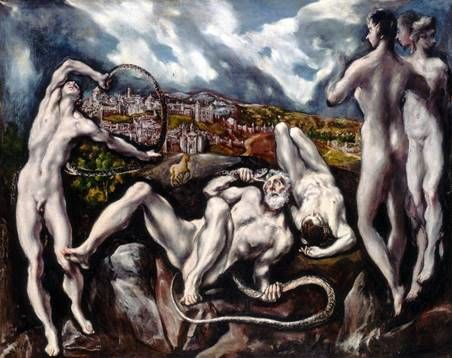
Approximately in 1610, El Greco painted the painting Laocoon. It depicts the heroes of the myth of the Trojan War, according to which the priest Laocoon, tried to warn the Trojans from excessive credulity to enemies, and not to drag a wooden horse into the fortress. For this the gods became angry and punished an alert priest: the snakes strangled Laocoon with their sons. The frightened townspeople hastened to drag the horse to Troy.
In 1506 in Rome was discovered a sculpture “Laocoon and his sons”, made by Rhodes sculptors. She inspired many artists and sculptors of the era. Among them was El Greco. However, he creatively rethought the famous myth, applying it to the present, and of all the works known to date El Greco, “Laocoon” – the only one on the mythological plot. In the late period of creativity, the master rarely used horizontal compositions, rather narrow and high formats of paintings. However, in the “Laocoon” there is a desire to climb, due to elongated figures on the edges of the picture.
Against the backdrop of the fortress of Toledo, which appears in the image of the legendary Troy, depicts large naked human figures. The priest and one of his sons are already thrown onto the rocks. The young man limp on the ground, losing the battle with severe rock. An elderly, but strong father, straining all his strength fights fiercely with a snake. However, the battle is almost lost and death can not be avoided, you can only postpone it for a while. The second youth is still standing, but his death is already predetermined – the snake bites his side. With helpless despair he looks into the sky, but there is no salvation, the heavens are deaf to the pleas of the unfortunate.
On the right are the figures who witnessed the tragedy. For a long time viewers could see only two figures. During the restoration, conducted in 1955-1956, a third was discovered, which is almost entirely hidden by the characters in front. Before the astonished restorers, as if from a non-existence, a previously hidden person appeared – under the layer of paint between the two heads a third head was found, then the fifth leg below. For what reason this figure was painted, is still unknown. Perhaps, El Greco himself turned the trio into a duo, or maybe the next generation concealed it. It is believed that the painting was never finished, the artist’s death prevented it.
Traditionally it is considered that the pair on the right is female and male figures, but there are no convincing arguments in favor of this point of view. Perhaps, they were originally conceived as some asexual spiritual entities. At different times they were seen as images of Adam and Eve, Paris and Helen, Poseidon and Cassandra, Apollo and Artemis.
In the interval between the group in the foreground and the walls of the fortress, you can see a live horse, slowly galloping towards the city. Why in the picture of El Greco a wooden horse proved to be alive and able to get into the city without help, and where are the crowds of triumphant Trojans? Such was the interpretation of the great master. For him, evil rock is always alive.
 Laocoon – El Greco
Laocoon – El Greco Toledo by El Greco
Toledo by El Greco Pieta, or Lamentation of Christ by El Greco
Pieta, or Lamentation of Christ by El Greco Healing the Blind by El Greco
Healing the Blind by El Greco Christ carrying the cross by El Greco
Christ carrying the cross by El Greco The funeral of Count Orgas by El Greco
The funeral of Count Orgas by El Greco Apostle James Zebedee by El Greco
Apostle James Zebedee by El Greco Removing clothes from Christ (Espolio) by El Greco
Removing clothes from Christ (Espolio) by El Greco